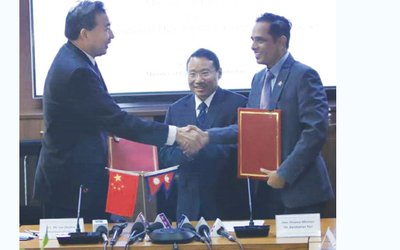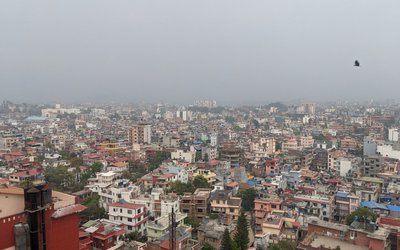Executive Chairperson of the Center for Environmental and Agricultural Policy Research, Extension and Development (CEAPRED) Hari K. Upadhyaya, Ph.D, likes to avoid publicity but he leads an organization that has over the years transformed the lives of many people across the country. He shares the credit for the success with friends and well-wishers, donors and staff but as Nepal chairs the World Summit of Least Developed Countries with a hope to transform the plights of the poor in countries around the world, Upadhyaya’s working style could be a model for those involved in development to follow. Upadhyaya spoke to KESHAB POUDEL on these issues. Excerpts:
How do you view the last two decades of successful performance of CEAPRED in Nepal?
We heard a lot about it and there was much for us to take pride in and be complacent. But we only consider this a strong reason for us to be inspired to do more and better in the future, and not be complacent.
Who are the sources of your inspiration?
We understand that the main source of our inspiration lies in the encouragement and support that we received from our friends and well-wishers, including donors, and in the dedication and commitment that our staffs have shown towards bringing positive changes in the lives of the people.
How do you share the credit for the success?
I would like to salute the collective initiatives and interests that people themselves took to make their development happen and sustain at the local level, and to our staff without whose dedication, commitment and hard work the organization would not have reached to its present level.
What are the prospects for agriculture in Nepal?
Agriculture has enormous potentials in Nepal but what we need to do is to reorient it to suit the local needs as well as to take local and national advantages.
Can we transform our livelihood by focusing on subsistence based traditional crops?
Rice, maze, wheat and millet based traditional crop system had its own characters. It guided the research with its production system. In Nepal’s context where average farm size is 0.8 hectare and 48 percent population has less than 0.5 hectares of land, the farmers cannot generate additional income and additional production by following food crop oriented agriculture. Even if they enhance productivity as much as they can, these crops cannot feed them for the year.
What crops have advantages in Nepal?
As Nepal’s advantage lies in diverse ecological settings, the country needs a crop which fits in ecological settings and in markets without losing competitive advantage at the national and international level. If we follow this, Nepalese farmers can generate enough money even from small farmlands. This has remained the orientation of CEAPRED since its inception.
Under this orientation, we launched vegetable farming targeting 1500 households in Dhankuta district. The idea is that elevation from Dharan to Bashntapur was the most appropriate for growing the vegetables. Between these areas, there is a tropical crop that can grow in Dharan and temperate crop in Basantapur. The advantage of this diversity is that our market reaches across the India. There is a tremendous market in India in case we supply the right commodity in the right time.
What commodity do you mean has ecological advantage?
Vegetables have ecological advantages. If we produce vegetables in a season when others cannot produce them across the border and in terai’s plains, our products have advantages. During the hot season of May, June, and July, one cannot grow cauliflowers in the plain, but the hills of Dhankuta and Basantapur can produce it because of low temperature or natural climate. The products which are produced in natural conditions in hills will be off-season products in plains and across the border. This means farmers do not need to compete in India.
What challenges do you see for farmers here?
The challenge for them is to produce as much as possible so that it feeds them round the year. Farmers have very little choice as either farmer can produce the food products which can meet their annual demand or they can produce other cash crops that will generate cash to buy food stuffs from market.
How do you see the impact of vegetables farming in poverty reduction?
It has a good impact. When we started our project in Dhankuta with support from the Danish Embassy, our target was to generate Rs. 10-15 thousand per household. Fortunately, we were able to generate an average of Rs. 19,000 in two years through off season vegetables. The project triggered the idea that if we tap local potential and ecological advantage, things and development can happen. When CEAPRED phased out in 1994 from Dhankuta, they produced 5700 tons of vegetable worth of Rs.20 million plus in a net of 570 hectares of land. In four years, the areas had tripled the production and income.
What were other impacts?
Along with income, it had far reaching implications in nutrition also.Visible implications were on the price of the land. The price of land,which used to have no real value, has gone up. Due to increase in nutrition, the number of school going children increased. The mobility of market increased too.
Because of more income, services developed. It was just not limited to vegetable growing and consumption. It had many linkages. Along with us, other organizations also took off-season vegetable as entry port to reduce the poverty. We did help people to come out of poverty in accessible areas where roads were there.
But, what are there in remote parts of the areas where poverty is rampant and the situation is very different than accessible areas like Dhankuta?
CEAPRED came out with an option for such areas. We decided to introduce low volume, high value and nonperishable commodities. One commodity for such places would be vegetable seed. In 1996/97, we piloted this project in Dolakha. This is a more technical and specialized activity and there is a need to enhance the capability of farmers and, linkages with the market.
How do seeds matter?
Whether it is productivity enhancement or increasing production, ultimately it boils down to the availability of good quality seeds. It was seeds which made green revolution possible. Even if we want another revolution in terms of bio-technology, eventual output is based on seed. It means there is a need of quality seed production. This is still an issue in cereal products. Production of quality seed is contributing to the whole process. If we produce quality seed locally, it will enhance the production sector.
What are other potentials from seeds?
It has tremendous potential for export also. For instance, the countries like Bangladesh and India are importing seeds worth millions of dollars. After looking at all these factors, we thought that the vegetable seed is one of the prospective sector. Piloted from Dolakha district in 1996, the seed project worked. With the support from SDC,we have been doing this in mass scale since 2002. Now we are in 16 districts and we exported a large amount of seeds. We have quality control mechanism with well equipped labs.
What options do you see for those who do not have the land?
Many landless people are left out. According to a report, there are over one million landless households. For them, CEAPRED introduced livestock and non-farming enterprises. In livestock also, we introduced the collective livestock. One cannot change the livelihood just by offering one or two goats. There is a need of a sizable scale of livestock. The strategy to encourage sizable scale livestock is one of them.
Is poverty reduction an economic phenomenon?
Poverty reduction is not only an economic phenomenon, it has social,political and economic dimensions. But, for sure, you need to address the issue of economic empowerment. Overall, total poverty reduction is related to economic empowerment. Just educating a poor individual, socially and psychologically, cannot bring tangible changes. In the context of gender, women are lagging behind men. I use this example that there is a poor woman in a rich family but there can never be a rich woman in a poor family. Economic empowerment is the bottom line.We are guided by this idea. All human insights and potential will be harnessed only when one can understand ‘who I am’. That will not happen without economic empowerment.
How does economic empowerment work?
One does not need to be a millionaire. Only after economic empowerment, then you can talk about environment, health, nutrition, climate change. Our bottom line is economic empowerment. In Nepal’s context where an overwhelming majority of people including the poor and disadvantaged are involved in agriculture, there is the need to reorient the agriculture for a sustainable poverty reduction. Our vision is an agricultur-led economic empowerment.
What’s your experience so far?
For almost twenty years now, I have always advocated three Ps: right policy, right program and right process. Policies are pillars and program structure and process the way you mix the raw materials in construction of building. The policy should not hurt the poor and the program should focus on activities where the poor are involved.
Who is the poor?
Conceptually, a typical poor is psychologically disempowered with a small piece of individual production unit. He or she cannot send his/her production to the market because of the lack of strength. Poor don’t have individual access to services and they don’t have collective voice, capacity and organization. The poor don’t havemoney, infrastructure and opportunity as well.
Do you think off-season vegetables can reduce poverty in countries like Nepal?
For a country like Nepal, with an overwhelming number of poor,off-season vegetables are best way to reduce poverty. This is what we have done successfully not only in Dhankuta but also in Kavre district. Farmers are harvesting money through this. Many people are wondering when they see a small farmer with one ropani of land generating up to Rs. 70,000 by growing off session vegetables. A small farmer is really cultivating money. He is harvesting money. It shows that something can be done but many do not know how to do it.
The second stage is capacity building in terms of technologies. They don’t know where to get the varieties and when to grow them. Farmers, who used to produce cauliflower during the winter, are now producing it in spring or April and May. They need ecologies plus resources to bring the changes. For instance, the poorest of the poor do not have even five hundred rupees n their hands. They don’t have access to minimum financial resources. They have little money to purchase seed. They don’t have water to irrigate the land. If they manage all these things, they face another problem, that is, access to market. If the market is far, they cannot carry it individually. If there is a collection center, farmers can sell it to the market. In such circumstances, there is a need to develop financial and technical capability of the farmers.
So what do you propose?
For instance, we have not changed the ecology of Dhankuta as farmers were growing cauliflowers even then. But, they were producing it individually in small volumes. When prices of cauliflower elsewhere used to range between Rs. 10 to 15, its price in Dhankuta was two to three rupees.The disadvantage was that the farmers used to sell it individually. Private businessmen carried enough in bulk. Price was used to be set by businessmen. In economic terms, there used to be monopolistic buyer and monopolistic competition. Farmers were saying that they could all come together and set the price. There is a competitive market on the buyer side. We termed it a human centered delivery system. In this process, the local capacity also enhanced so that the activities we have started continued even after the phaseout.
Do you think your programs are sustainable?
When we left after two years, many challenged the sustainability of the program. However, farmers have shown that they can sustain in case they have the institutional capability. One can build the institution within a year of implementation but in some cases one cannot sustain even after running it for 30 years. Our strategy is that we don’t want to stay for a long period of time in one particular community. This is the reason we are able to expand services to 134,000 households. This is an ideal number. We are not saying that we are providing this kind of facilities to all families.
How does the climate change affect poverty?
In the context of the new issue of climate change, agriculture like elsewhere in the globe, is still a risky business. It is riskier now due to climate change. It will suffer from inadequate rainfall or drought or heavy rainfall. In this context, there is the need to think about risk mitigation. Interestingly, it is the poor who can mostly internalize the risk. The rich has access and opportunities and resources so they can cope. But those who have limited livelihood options, particularly the poor, cannot cope with the situation. The need for countries like Nepal, which is probably the fourth or fifth most affected country; we must do something to develop resilience to climate change and to increase the adaptation capacity. We have started to do it. We are also a part of regional climate change program. We are in the process of economic transformation from subsistence to specialization. In early stage, our agriculture was based on subsistence, now we are also doing specialized agriculture in pocket areas. Our next stage will be agro industry.
- TANAHU HYDROPOWER PROEJCT: A Significant Achievement
- Apr 15, 2024
- AMBASSADOR HANAN GODAR: Sharing Pain With A Nepali Family
- Mar 30, 2024
- VISIT OF KfW AND EIB TO NEPAL : Mission Matters
- Mar 25, 2024
- NEPAL BRITAIN SOCIETY: Pratima Pande's Leadership
- Mar 24, 2024
- NEPAL ARMY DAY: Time To Recall Glory
- Mar 15, 2024
















